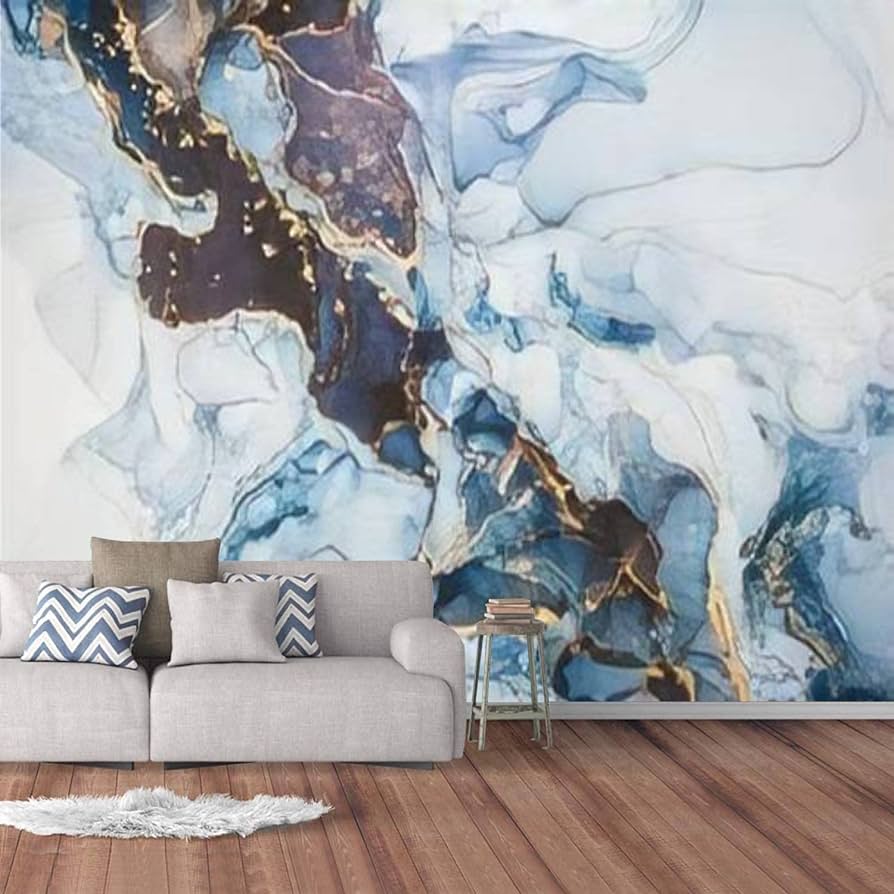Peel and stick murals offer a quick and stylish way to update your home decor. They are especially useful for renters or anyone who likes to change their decor frequently. However, installing these murals in tight spaces and corners requires careful planning and execution. This article will provide you with all the tips and tricks you need to achieve a flawless installation.
II. Preparing for Installation
A. Surface Preparation
Before you start, it’s crucial to prepare the wall surface properly. This ensures that the mural adheres well and looks smooth.
- Cleaning and Smoothing the Wall Surface: Use a damp cloth to clean the wall, removing any dust or dirt. For stubborn stains, a mild soap solution can be used. Make sure the wall is completely dry before proceeding.
- Filling Holes and Sanding Rough Areas: Fill any holes or cracks with spackle and sand them smooth. This will create a flat surface for the mural to adhere to.
- Priming the Wall for Better Adhesion: Apply a primer to the wall if it has a glossy finish or if you’re applying the mural to a newly painted surface. This helps the mural stick better.
B. Gathering Necessary Tools
Having the right tools on hand will make the installation process much smoother.
- Utility Knife or Scissors: For cutting the mural to size.
- Smoothing Tool or Squeegee: To smooth out air bubbles and wrinkles.
- Tape Measure and Level: For accurate measurements and ensuring the mural is straight.
- Ladder: For reaching high areas.
III. Measuring and Cutting
A. Accurate Measurements
Accurate measurements are key to a successful installation.
- Measuring Wall Dimensions, Including Obstacles: Measure the height and width of the wall, including any windows, doors, or other obstacles.
- Adding Extra Material for Trimming: Add a few extra inches to your measurements to allow for trimming and adjustments.
B. Cutting the Mural
Cutting the mural to the correct size before installation will save you time and hassle.
-
- Cutting Strips to Size Before Installation: Cut the mural into manageable strips, making sure to label them for easy application.
- Labeling and Organizing Strips for Easy Application: Organize the strips in the order they will be applied to avoid confusion.
IV. Installing the First Strip
A. Marking a Guide Line
A straight guide line will help ensure your mural is applied evenly.
- Drawing a Straight Line for Alignment: Use a level to draw a straight vertical line on the wall where the first strip will go.
- Importance of Starting with a Straight First Strip: Starting with a straight strip is crucial for the rest of the mural to align properly.
B. Applying the First Strip
Applying the first strip correctly sets the tone for the rest of the installation.
- Peeling and Sticking the First Section: Peel off a small section of the backing and stick the top of the strip to the wall. Gradually peel off more backing as you smooth the strip down the wall.
- Smoothing Out Air Bubbles and Wrinkles: Use a smoothing tool to press the strip firmly against the wall, removing any air bubbles or wrinkles as you go.
V. Navigating Corners and Tight Spaces
A. Inside Corners
Inside corners can be tricky, but with the right technique, you can achieve a seamless look.
- Aligning and Smoothing the Mural into the Corner: Apply the mural up to the corner, then use a smoothing tool to press it into the corner.
- Overlapping Seams for a Seamless Look: Overlap the next strip slightly to ensure there are no gaps.
B. Outside Corners
Outside corners require careful handling to ensure the mural wraps smoothly.
- Wrapping the Mural Around the Corner: Gently wrap the mural around the corner, smoothing it as you go.
- Ensuring Proper Alignment and Adhesion: Make sure the mural is aligned correctly and press firmly to ensure it sticks well.
VI. Working Around Obstacles
A. Windows and Doors
Windows and doors can interrupt the flow of your mural, but with careful trimming, you can achieve a professional finish.
- Trimming Excess Material Around Frames: Use a utility knife to trim the mural around window and door frames.
- Making Relief Cuts for a Snug Fit: Make small relief cuts in the mural to help it fit snugly around corners and edges.
B. Electrical Sockets and Switches
Safety is paramount when working around electrical sockets and switches.
- Turning Off Power for Safety: Always turn off the power before working around electrical outlets.
- Cutting Around Sockets and Switches: Use a utility knife to carefully cut the mural around sockets and switches, ensuring a neat finish.
VII. Adjustments and Finishing Touches
A. Smoothing and Trimming
Final adjustments will ensure your mural looks perfect.
- Using a Smoothing Tool to Remove Bubbles: Go over the entire mural with a smoothing tool to remove any remaining air bubbles.
- Trimming Excess Material Along Edges and Baseboards: Use a utility knife to trim any excess material along the edges and baseboards for a clean finish.
B. Pattern Alignment
Ensuring the pattern aligns correctly across strips is crucial for a seamless look.
- Ensuring Patterns Match Across Strips: Take your time to align the patterns on each strip before sticking them down.
- Making Slight Adjustments for a Perfect Fit: Make small adjustments as needed to ensure the pattern matches perfectly.
VIII. Common Mistakes to Avoid
A. Poor Surface Preparation
Skipping surface preparation can lead to poor adhesion and a less-than-perfect finish.
- Importance of a Clean and Smooth Surface: Always clean and smooth the wall before applying the mural.
B. Misalignment
Starting with a misaligned strip can th click this row off the entire mural.
-
- Ensuring the First Strip is Straight: Use a level to ensure the first strip is perfectly straight.

C. Inadequate Adhesion
Not applying enough pressure can result in the mural peeling off.
- Using the Right Amount of Pressure and Smoothing: Press firmly and use a smoothing tool to ensure the mural sticks well.
IX. Tips for a Professional Finish
A. Taking Your Time
Rushing the installation can lead to mistakes.
- Importance of Patience and Precision: Take your time to ensure each strip is applied correctly.
B. Seeking Help
Having an extra set of hands can make the process easier.
- Benefits of Having an Extra Set of Hands: Enlist a friend or family member to help with the installation, especially for larger murals.
X. Conclusion
Installing peel and stick murals in tight spaces and corners can be challenging, but with the right preparation and techniques, you can achieve a professional finish. Remember to take your time, prepare the surface properly, and use the right tools. With these tips, you’ll be able to transform any room with ease. Happy decorating!

Meet Hi there! I’m Jason Noon, a passionate Product Consultant specializing in mural design and customization. Welcome to MuralMoxie, where creativity meets craftsmanship. My journey into the world of murals began over a decade ago. I started as a graphic designer, but my love for large-scale art installations quickly took over.





